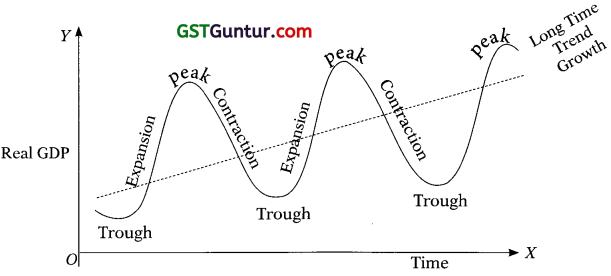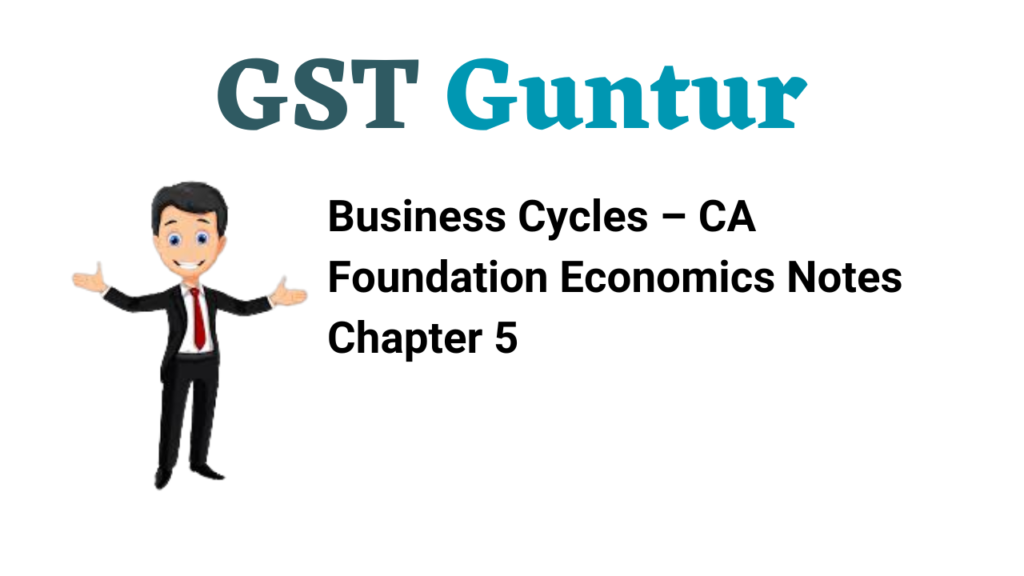Browsing through CA Foundation Business Economics Notes Chapter 5 Business Cycles help students to revise the complete subject quickly.
Business Cycles – Business Economics CA Foundation Notes Chapter 5
All countries have gone through fluctuations in economic activities i.e. ups and downs in its economic activities. In other words, every country passes through a pattern where there are period of economic growth, followed by periods of slowing growth and even failing growth. There are periods of prosperity followed by downturns. Thus, “The Business Cycle is the periodic fluctuations in economic activity measured by change in Real GDP.”
![]()
Although these economic fluctuations are recurrent and occur periodically, they are not at regular interval and are not of same length.
Phases of Business Cycle:
→ A business cycle passes through the following four distinct phases:
- Expansion/Boom/ Recovery/ Upswing
- Peak/Boom/Prosperity
- Contraction/Recession/ Downswing
- Trough/Depression
→ The following figure shows the four stages of the business cycle.

In the figure above the four phases business cycles are shown. The broken line represents long time growth trend or potential GDP. It shows rising trend of growth over a period of time. The figure starts from Trough when the overall economic activities i.e. level of production and employment are at the lowest level.
With increase in the economic activities the economy moves into Expansion Phase. But expansion phase cannot continue indefinitely, and after reaching Peak, economy starts contracting i.e. Contraction Phase sets in and continue till it reaches the lowest turning point called Trough. Here cycle completes and new cycle starts.
Expansion:
→ In the expansion phase, there is increase in Output and Employment. Expansion phase is characterized by –
- increase in national output,
- increase in employment,
- increase in aggregate demand,
- increase in capital i.e. investments,
- increase in consumer spending,
- increase in sales, profits, stock prices, & expansion of bank credit.
- increase in standard of living.
There is no Involuntary unemployment and whatever unemployment exist is only of Frictional or Structural in nature.
The growth ultimately slows down and reaches its peak.
Peak:
Peak phase of the cycle is the highest point. The economy is producing at its maximum level. The economy becomes overheated i.e. unsustainable. The expansion phase ends here. The prices of inputs increase, resulting higher cost of production, leading to higher output prices. Higher output price leads to increased cost of living. Fixed income earners and consumers suffer. Economic growth stabilizes at peak an then starts the downswing.
![]()
Contraction:
In contraction phase. There is fall in Output and Employment levels. Contraction phase is go characterized by –
- fall in the level of investments,
- fall in the level of production and employment,
- fall in the incomes of people,
- demand and consumption of both capital goods and consumer goods fall,
- bank credit, shrinks as investments fall,
- stock prices fall,
- firms become pessimistic about future,
- there is lot of excess production capacity in industries.
There is large scale involuntary unemployment.
A severe contraction or recession of economic activities pushes the economy into Depression.
Trough and Depression:
→ The lowest level of economic activity is called trough or depression. All economic activity touch the bottom and the phase of trough is reached. Trough is the turning point into expansion. Increased investments lead to increase in consumption. Therefore, industries expand production and start using their idle production capacity and rate of unemployment falls. With this the cycle is complete.
→ It is very difficult to predict turning points of business cycles. Changes in different economic activities is used to measure the business cycle and to predict in which direction the economy is headed. There are three types of economic indicators, depending on their timing namely
- Leading Indicators,
- Lagging Indicators, and
- Coincident Indicators
Leading Indicators signal future changes:
→ Leading Indicators change before the economy itself changes Le. change prior to large economic adjustments.
Example – changes in stock prices, profit margins and profits, the house market, manufacturing activity, etc. Leading Indicators should be used with caution as they may not be always accurate.
→ Lagging Indicators usually change after the economy as a whole changes i.e. after the real out put changes. Lagging Indicators are useful to confirm the business cycle.
Example – unemployment, the consumer price index, interest rates, lending by banks, etc.
→ Coincident Indicators also called Concurrent Indicators occur at about the same time with business cycle movements. They give us idea about current state of economy.
Example – GDP, inflation, industrial output, personal income, etc.
Features of Business Cycles:
- Business cycles occur periodically. They do not show same regularity, duration and intensity.
- The length of different phases of business cycles is not definite and hence do not show smoothness and regularity.
- Business cycles do not bring about changes in one industry or sector but occur simultaneously in all industries and sectors. Further, it passes from one industry to another.
- Fluctuations take place not only in the level of output but also in other related variables like consumption, employment, investment, interest rates and price level.
- Cyclical fluctuations affect adversely the consumption of durable goods like capital goods, scooters, cars, houses, refrigerators, etc. Their demand falls. As a result investments become unstable.
- However, consumption of non-durable goods and services does not vary much during different phases of business cycle.
- Business cycles causes lot of uncertainty for businessmen and forecasting becomes difficult. Profits fluctuate.
- Business cycles affect the inventories of goods. During depression inventories start accumulation more than the desired level. This results reduction in the production. When recovery starts, inventories are below the required level.
- Business cycles are international in character.
![]()
Causes of Business Cycles – Business Cycles may occur due to internal and external causes or a combination of both.
Internal Causes (Endogenous Factors):
Internal causes of business cycle are those, which are built within the economic system. They are –
(1) Fluctuations in Effective Demand:
Fluctuations in economic activities is due to fluctuations in aggregate effective demand. When aggregate demand falls, it results in lower output, income and employment. This causes a downward spiral. Increase in aggregate demand causes conditions of expansion and boom.
(2) Fluctuations in Investments:
Investments fluctuate because of changes in profit expectations of entrepreneurs. High investments brings increase in aggregate demand and thus result in upswing and vice versa.
(3) Variations in government spending:
Fluctuations in government spending affects the economic activities and results in business fluctuations.
(4) Money Supply:
According to Hawtrey and Friendman, business cycles relate to fluctuations in money and credit supply. Cheap money policy leads to expansion of money and credit supply resulting in increased economic activities and vice versa.
(5) Monetary and Fiscal Policies:
Monetary and Fiscal Policies also cause business cycles. Expansionary policies, like low interest rates, rates increased government spending and tax cuts boost economic activities. It there is inflation opposite will be done resulting in showing down of economy.
(6) Psychological Factors:
According to Pigou, business cycles appear because of the optimistic and pessimistic mood of the business community. It business community is optimistic about future market conditions, they make investments. Here, the expansion phase starts ultimately leading to boom and vice versa.
(7) Other Factors:
- According to Schumpeter, business cycles occur due to innovations that take place from time to time in economic system. (Innovation Theory)
- According to Nicholas Kaldor, the present fluctuations in prices are responsible for fluctuations in output and employment in future (Cobweb Theory)
External Causes (Exogenous Factors):
(1) Wars:
During war time, all the available resources are used up for the production of arms – and ammunitions. This results in the fall of production of capital and consumer goods.
This in turn causes fall in income, profits and employment and contraction in economic activities take place which may lead to depression.
(2) Post War Reconstruction:
After war, the level of consumption and investment goes upward. Both the government and individuals are involved in construction.
Example – houses, roads, bridges, communication, etc. The economy picks up resulting in higher output, employment and income.
(3) Technology:
Another cause of business is scientific development leading to improved technology. Adoption of new technology for production of new and better goods and services require huge investments. Increased investments increases employment income and profits this gives boost to the economy.
(4) Natural Factors:
Weather cycles causes fluctuations in agricultural output. If in any year, weather is good the output of agriculture sector will increase. This will also increase the demand for industrial goods and vice versa.
(5) Population Growth:
If the population growth rate is higher than the economic growth rate, income level will be low. This will result is lower savings and investments and therefore, lower income and employment.
![]()
Relevance of Business Cycles in Business Decision Making:
→ Understanding the business cycle is important for all types of business enterprises because it affects the demand for their product and in turn their profits.
→ Knowledge of business cycles, its phases and characteristics help the business enterprises to frame appropriate policies.
Example – New opportunities for investment, employment and production opens up at the time of prosperity. So understanding the economic environment is important white making business decisions.
→ Business managers have to advantageously respond in complex time during the whole business cycle through boom, downswing, recession and recovery to arrive at sound strategic environment.
→ We have seen that business cycles do not affect all the sector uniformly. Some business are more vulnerable white others are not or less vulnerable to changes in business cycle. Businesses like fashion retailers, electrical goods, restaurants, constructors, advertising, foreign tour operators, etc. are directly linked with economic growth. Such business are called cyclical businesses. So during recession such businesses slump and vice versa.
→ The phase of the business cycle is important to decide on entry into the market by a new firm or to decide about launch of a new product.
